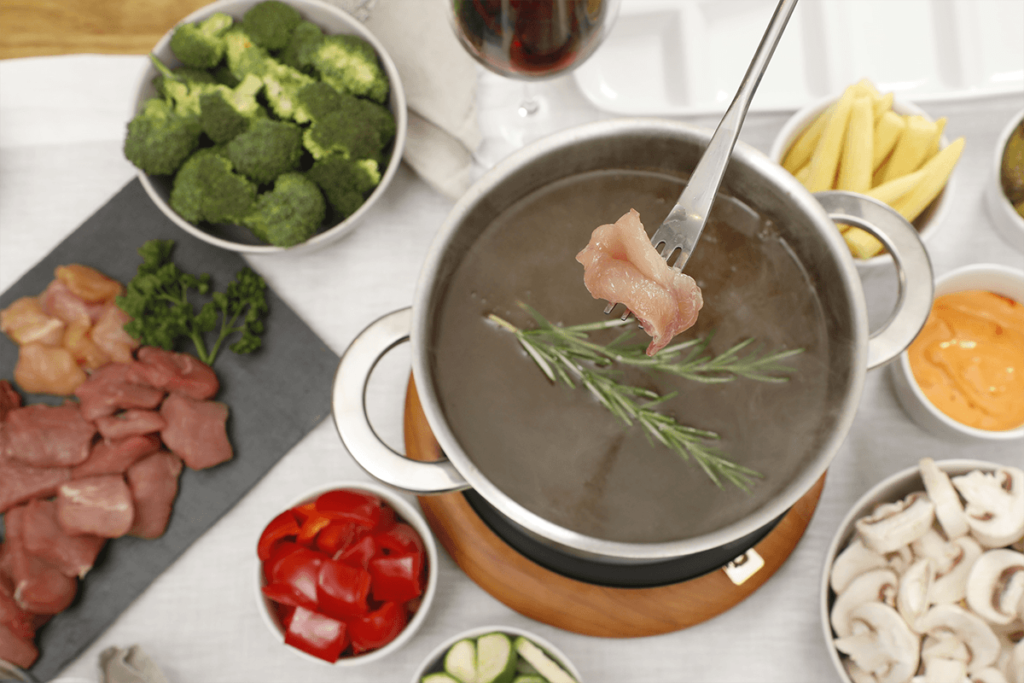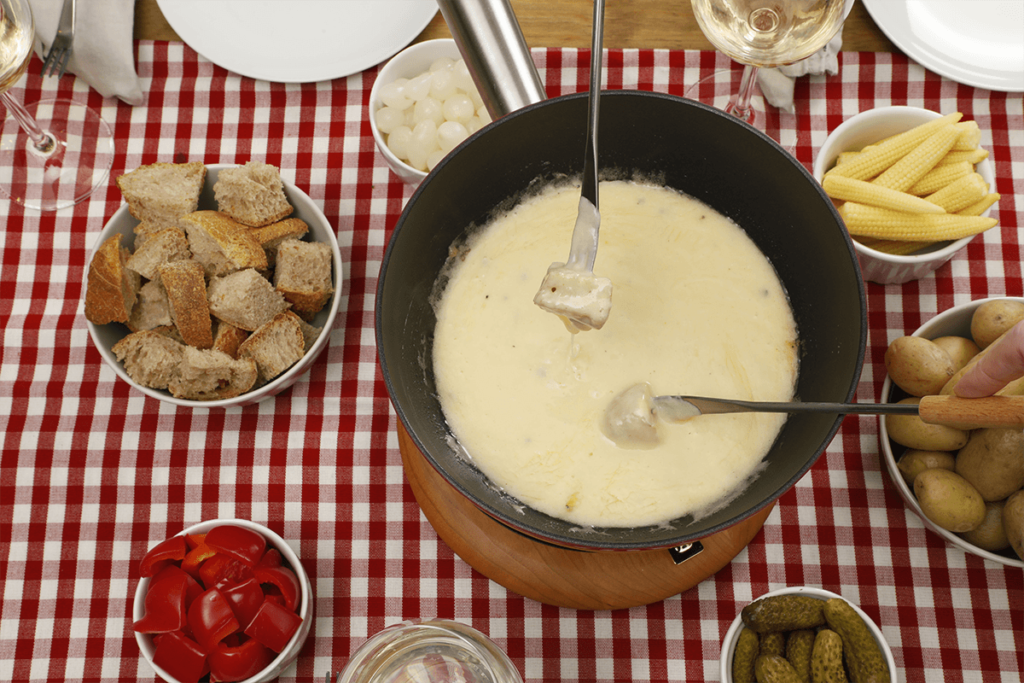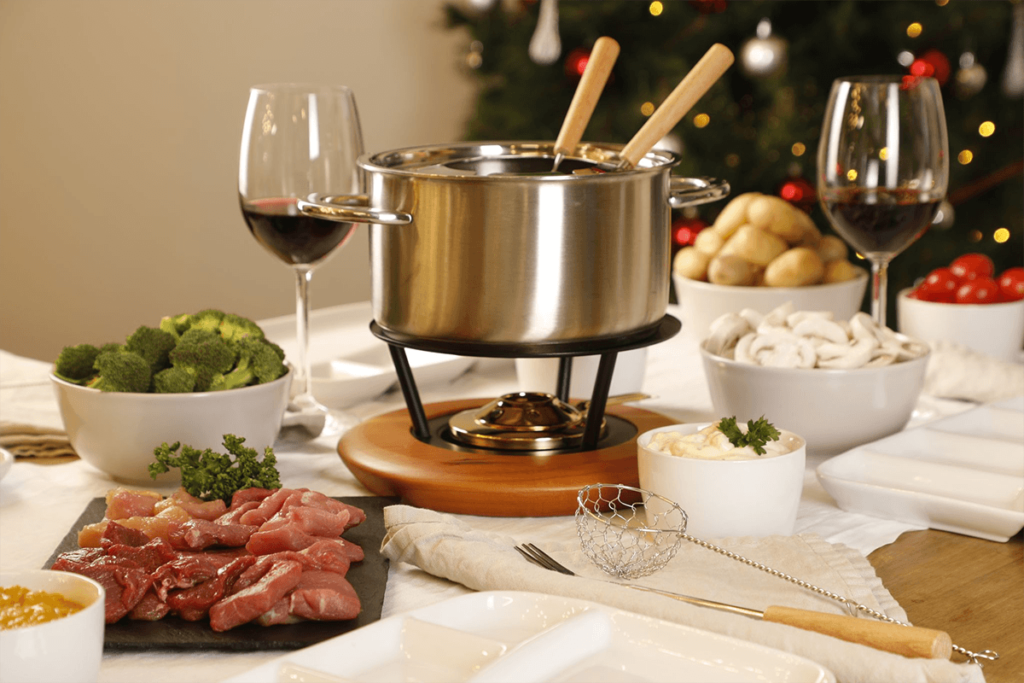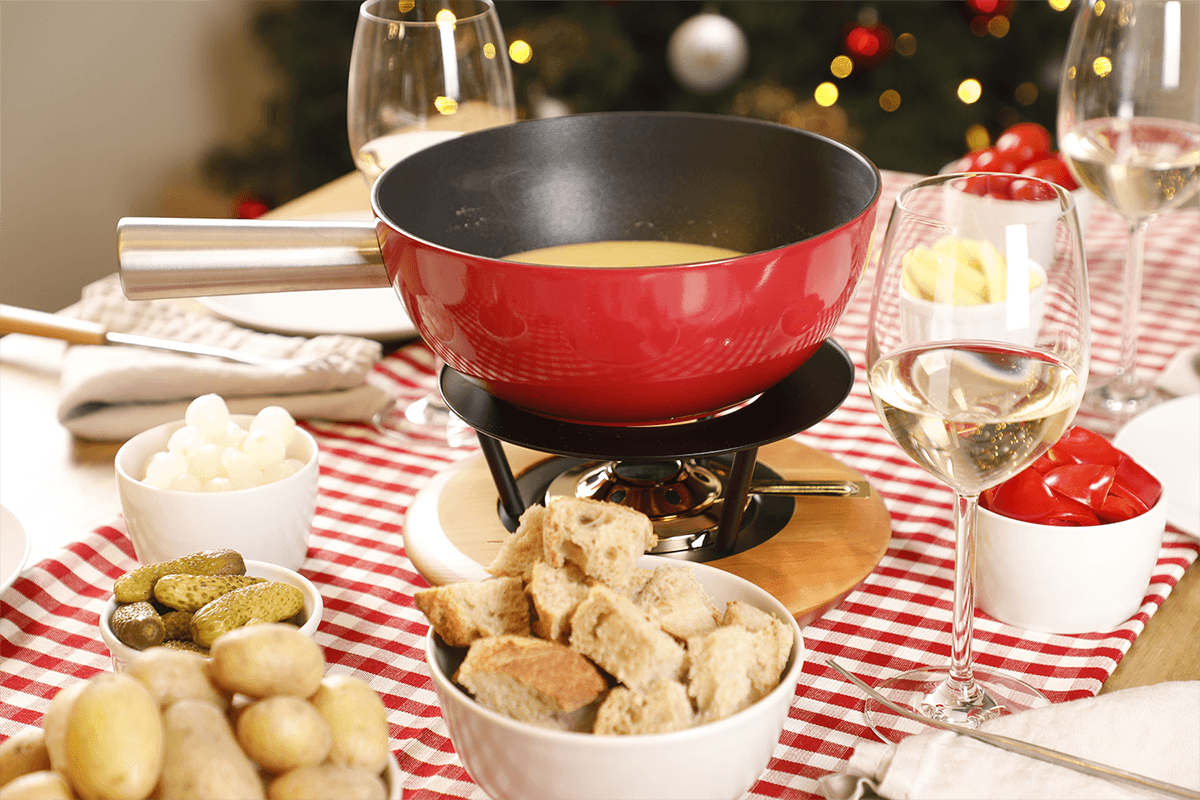Steaming, melted cheese that draws golden threads as soon as you dip it into this crispy bread cube. Fondue is not only delicious — this Swiss national dish is an uncomplicated and versatile all-rounder with a high symbolic value, and is one of the most popular Advent and Christmas dishes in Switzerland.
How Fondue Became a Swiss Classic
Where did fondue actually come from? The origin of the name is no hidden secret, as it comes from the French fondre which means “to melt”. In fact, the actual origin of the national dish is surrounded by numerous myths and legends.
A fondue-like dish — a mixture of goat cheese, wine and white flour melted over an open fire — was first described in Homer’s work “Iliad” some 2,800 years ago. But it is uncertain whether the ancient Greeks actually invented fondue with this.
Fondue was mentioned early on in a variety of sources which pointed to the spread of the dish in Swiss towns. For example, Margaretha Gessner from Zurich wrote down her own fondue recipe at the end of the 17th century. In 1768, the philosopher Jean-Jacques Rousseau noted in one of his letters that he preferred gruyère cheese for fondue.
In many places, it is said that fondue was invented by a poor shepherd in the Western Swiss Alps who wanted to introduce variety into his diet. By dipping bread in melted cheese, he may have created a legendary Swiss dish… Or maybe not? This story is well known, but unfortunately there is no way alpine dairymen invented fondue. Although they made cheese from milk, it would have been nigh on impossible for the alpine dairymen to transport the quantities of flour and wine needed for a fondue when they went up the mountain.
In fact, this myth was created between the First and Second World Wars, at the time when cheese fondue became the Swiss national dish. The alpine reference of the story was perfectly suited to marketing fondue as a favourite Swiss dish. Due to the economic crisis of the 1930s, many Swiss cheese producers struggled to get rid of their products. It was at this point that the Swiss Cheese Union became active and, for the first time, did plenty of advertising for fondue in order to boost cheese consumption in Switzerland.
This was followed by numerous other advertising campaigns — perhaps you are familiar with the Cheese Union’s advertising slogan FIGUGEGL from the 1950s: “Fondue isch guet und git e gueti Luune”. Not only was cheese fondue then enjoyed by the Swiss army in the sixties, but in the seventies it was also part of the 16th volume of the comic series Asterix, which is set in Switzerland. And so the bubbling cheese dish soon established itself as a Swiss cultural icon.
Types of Fondue

Bringing a group of people together for a cosy evening, dipping cut-up delicacies into a common pot bubbling with hot liquid. All types of fondue have this in common. But where are the differences?
- Cheese Fondue is the oldest type of fondue and therefore the absolute Swiss classic. Crispy bread cubes or potato pieces are dipped into a creamy mass, which consists mainly of cheese and white wine.
- Beef/Meat Fondue (oil fondue) refers to the fondue in which meat or fish and vegetables are cooked in hot fat. This can be fondue fats and oils, but also refined rapeseed oil, sunflower oil, peanut oil or soya oil.
- Chinese Fondue (Hot Pot) originally comes from Asia and follows the same principle as Meat Fondue – except that the pot is filled with a spicy broth, usually bouillon, instead of oil.
- Wine Fondue is a special type of fondue. With this type of fondue, thinly sliced meat is prepared in boiling, dry red or white wine. Usually the liquid is enhanced with broth and various spices and herbs.
- Chocolate Fondue is the sweet counterpart of the aforementioned varieties, in which pieces of fruit are dipped into warm, liquid chocolate.
Fondue at Christmas

In Germany it’s the Christmas goose, in Great Britain, the turkey. The Swiss, however, do not officially have a classic Christmas dish. Instead, the Christmas tradition in Switzerland is to gather family and friends for a cosy celebration — with lots of delicious food, of course! Meat, especially poultry, ham roast or fillet in pastry, is particularly popular.
It’s not surprising that fondue is high on the Christmas list, as it is a warm and sociable Christmas meal requiring little time or effort. After all, the Christmas shopping and presents are enough to stress you out!
How Fondue Works: Basics, Side Dishes, Dips & Tips!
Enough about the Swiss classic — time for some practical tips to make sure fondue works for you!

First, you need the right equipment. The heated fondue mixture is kept warm in a caquelon, a thick-walled pot, heated by chafing fuel. This fuel comes in a paste, gel, or gas form and serves as a heat source for the bubbling fondue liquid. Depending on the type of fondue, the temperature is important: 100°C for broth fondue, 160-180°C for oil fondue and 55-60°C for cheese fondue.
A caquelon made of ceramic, cast iron, stone or porcelain is best suited for the cheese fondue, as these materials transfer the heat very slowly. The thick base also prevents the cheese mixture from overheating or burning. The delicious crust that forms on the bottom of the cheese fondue is called Grandmother or the Nun.
Meat Fondue and Chinese style fondue require a metal caquelon, ideally made of stainless steel or cast iron, which conducts the heat better than conventional fondue pots. The reason for this is that the oil or broth must be boiling hot so that raw ingredients can pass through properly. A lid and a splash guard are also very important — you don’t want to burn yourself with hot oil!
For cheese fondue, one fork per guest is enough. With oil and broth fondue, you can count on two forks per person, so you can cook a piece of meat and vegetables at the same time. Fondue cooking baskets or sieves are also particularly useful for meat fondue, as they allow you to scoop the ingredients out of the liquid.
While ordinary plates can be used for cheese fondue, it is recommended that special plates (with cavities for side dishes and sauces) be used for the meat version. Raw meat (especially poultry) and its juice must never come into contact with other foods!
Now for the ingredients: Should it be a cheese fondue? The fact is — it all depends on the mixture! You decide whether it should consist of Appenzeller, Gruyère, Emmental, Beaufort, Vacherin or other types of cheese. Browse through our cheese fondue assortment and discover your favourites! For a cheese fondue party, plan for 200 grams of cheese mixture per person. Boil it up with a dry white wine and, if desired, a shot of cherry brandy. Then season the mixture with garlic, pepper and, if you like, a pinch of nutmeg or paprika. It goes well with white, half-white, brown or even wholemeal bread — it is best if each piece has a little crust so that it does not get lost in the pot. Alternatively, you can also dip pieces of cooked bread, vegetables or even fruit into the delicious cheese mixture. A variety of side dishes such as pearl onions, baby corn, gherkins, olives, dried tomatoes and much more go well with it!

Maybe a meat fondue? Fill the caquelon about half way (depending on the size of the pot) with about 1 kilogram of fat, 1 litre of oil or 1 to 1.5 litres of broth. Prepare about 200-250 grams of meat per guest, cut as thin as possible (approximately 5 millimetres). Discover our Meat Fondue and Chinese Fondue range. Each person should also have about 150 grams of firm vegetables (cut into bite sized pieces) such as carrots, mushrooms, broccoli, pumpkin, peppers or whatever else pleases them. Also note that the meat pieces must be cooked for 2-3 minutes in the fondue liquid to be completely done. They can then be dipped and enjoyed in a variety of fine sauces such as cocktail, garlic, tartar or curry dip, spiced butter, chutneys, ketchup or mayo. The subsequent side dishes for meat fondue are as varied as the dips: from salads, jacket potatoes, white bread, crisps to perfumed rice! And, of course, the little things like pearl onions, baby corn and gherkins should not be forgotten.
Utilise Leftovers
Did you overestimate the number of ingredients for your meat fondue? Wondering what to do with the leftover meat and vegetables? Don’t just throw them away! Refrigerate the pieces of meat and vegetables immediately after the fondue and use them later to create delicious dishes: such as meat and vegetable skewers, gschnetzlets (meat in a mushroom cream sauce), wok pan, curry or meat ragout.
There are also no limits to your creativity when it comes to cheese leftovers, as they can be reused (and transformed) without any problems. For example, they fit into a casserole, a cheesy pasta sauce or spaetzle, a lasagne, a cheesecake, an omelette and as a side dish for rösti or a filling for ham and cheese croissants. The bread leftovers can make for some delicious crunchy croutons.











What do you think?